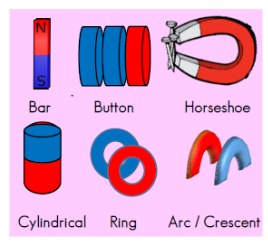FRICTION
When objects are pushed or pulled, an opposing force can be felt. This opposite force is called ‘friction’. Friction causes things to slow down or stop. The grip on our shoes stops us slipping. Therefore, friction is great. Ice-skates on an ice-rink will move for a long time because there is very little friction. The rougher the surfaces, the greater the friction. This rubbing of two surfaces can release energy, causing heat.

MAGNETS
A magnet is a special object which produces an area of magnetic force around itself called a magnetic field. If a metal object enters this magnetic field, they will be attracted towards the magnet and end up sticking to it – non-metallic objects would not be attracted to it. N.B. some forces need contact between two objects, but magnetic forces can act at a distance. Magnetic materials
are always made of metal, but not all metals are magnetic. Iron is magnetic, so any metal with iron in it will be attracted to a magnet. Nickel and Cobalt are also magnetic. Steel contains iron, so a steel paperclip will be attracted to a magnet too. Most other metals, for example aluminium, copper and gold, are NOT magnetic.

MAGNETIC POLES
The two ends of a magnet are known as the north pole (N) and the south pole (S). The same poles repel— opposite poles attract. If you try to put two magnets together with the same poles pointing towards one another, the magnets will push away from each other. We say they repel each other. Opposite poles attract and are brought together.

Focus Scientist
William Gilbert (1544-1603) should be much more famous than he is. He was the first person to prove that the earth was a giant magnet and to link electricity and magnets. He was also one of the first British fans of the scientific method.

Mary Somerville (1780-1872) was fascinated by magnets and carried out lots of experiments with them. She was also one of the first popular Science writers – selling many books in her lifetime.
She was the first woman to be elected for the Patron’s Medal of the Royal Geographical Society for Physical Geography.

Key Vocabulary
forces: the pushes and pulls which act on our bodies and the things around us to make things move and stop moving.
materials: the matter or substance that objects are made from. Different materials have different features, or properties, which make them suitable for different uses.
push/pushing: any action moving an object away from you.
pull/pulling: any action moving an object towards you.
friction: a ‘sticking’ force – the resistance that a surface or object encounters when moving over another surface or object. E.g. Air resistance, water resistance and surface resistance.
magnet: an object that has a magnetic field (an invisible pattern of magnetism). A magnet attracts or repels other items. magnetic force an invisible force created by electrons.
Magnetic force: controls magnetism and electricity.
poles: the north pole is the end of the magnet attracted to the Earth’s North magnetic pole; a magnet’s south pole is the end attracted to the Earth’s South magnetic pole.
attract: to pull together with physical force.
repel: to move or force back or away.
contact force: a force that must directly touch another object to affect it.
non-contact force: a force that affects something at a distance e.g. gravity or magnetism.
Force and Magnet
Objectives
Students will be able to
- compare how things move on different surfaces.
- notice that some forces need contact between two objects, but magnetic forces can act at a distance.
- observe how magnets attract or repel each other and attract some materials and not others.
- compare and group together a variety of everyday materials on the basis of whether they are attracted to a magnet, and identify some magnetic materials.
- describe magnets as having two poles.
- predict whether two magnets will attract or repel each other, depending on which poles are facing.
What is a force?
A force is a push or a pull. Forces can make objects speed up, slow down, change direction or change shape.

Forces need contact between two objects. Imagine a football, when you kick it changes direction. It won’t change direction on its own until it hits something. Imagine dropping a book. It won’t stop until it hits the floor. It needs contact before it changes.
Magnets
Magnetic forces are forces that a made using a magnet. These don’t need to touch objects for it to cause a force, the magnet can either push or pull using a magnetic force.

Force and Magnets Worksheets
Forces affect motion
You can use force to make something move, stop it, speed it up, slow it down, change its direction, or change its shape.
Push, pull, or both?
A push is a force that moves something farther away. A pull is a force that moves things closer. Sometimes we pull things and sometimes we push them. Sometimes we do both!
- Pull and Push Force 1
- Pull and Push Force 2
- Pull and Push Force 3
- Pull and Push Force 4
- Frictional Force
